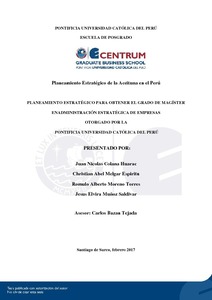| dc.contributor.advisor | Bazán Tejada, Carlos Armando | |
| dc.contributor.author | Colana Huarac, Juan Nicolas | es_ES |
| dc.contributor.author | Melgar Espiritu, Christian Abel | es_ES |
| dc.contributor.author | Moreno Torres, Romulo Alberto | es_ES |
| dc.contributor.author | Muñoz Saldivar, Jesus Elvira | es_ES |
| dc.date.accessioned | 2017-03-18T00:10:20Z | |
| dc.date.available | 2017-03-18T00:10:20Z | |
| dc.date.created | 2017 | |
| dc.date.issued | 2017-03-18 | |
| dc.identifier.uri | http://hdl.handle.net/20.500.12404/8262 | |
| dc.description.abstract | El sector olivícola en el Perú ha registrado en los últimos años un crecimiento, debido
al aumento de la demanda mundial lo cual está generando que el Perú aumente su oferta
exportable. El fruto del olivo en los últimos años ha tenido un crecimiento de superficie
cultivada, siendo la región Tacna e Ica el referente en este cultivo. Cabe destacar que el Perú
cuenta con ventajas competitivas para el desarrollo del sector olivícola, tales como la
capacidad de poder extender las áreas de cultivos actuales en toda la costa del Perú, y la
experiencia en este cultivo que es importante para obtener un producto de calidad. Pero aun
mantenemos un rendimiento de 3,7 tm/he que está por debajo de la media mundial. Las
exportaciones del Perú en este cultivo se centran principalmente a Brasil, Chile y EEUU.
Donde se compiten con importantes exportadores como Argentina en Latinoamérica y
España en Europa.
Para lograr alcanzar nuestra visión al 2026, se deben alcanzar nuestros cuatros
objetivos a largo plazo que son: (a) Al 2026 incrementar el área de cultivo de aceituna a
25,000 hectáreas, (b) Al 2026, el nivel de exportaciones de aceituna será 100,000 tm/año.
(Brasil: 70,000 tm/año; USA: 26,000 tm/año y UE: 14,000 tm/año), (c) Al 2026 incrementar
el rendimiento a 7.0 tm/ha, (d) Al 2026, posicionar la " Marca Perú" en todas las
exportaciones como símbolo de calidad y producto natural, para lograr estos objetivos a largo
plazo se trazaron también dieciséis objetivos a corto plazo y se propusieron trece estrategias.
La implementación de estas estrategias planteadas está ligada a la Visión, Misión,
objetivos de largo plazo y objetivos a corto plazo definidos en el proyecto y permitirán lograr
las metas trazadas al 2026 | es_ES |
| dc.description.abstract | The olive sector in Peru has registered growth in recent years, due to the increase in
world demand, which is causing Peru to increase its exportable supply. The fruit of the olive
tree in the last years has had a growth of cultivated surface, being the region Tacna and Ica
the referent in this culture. It should be noted that Peru has competitive advantages for the
development of the olive sector, such as the ability to extend current crop areas throughout
the coast of Peru, and experience in this crop that is important to obtain a quality product .
But we still maintain a yield of 3.7 mt / h which is below the world average. Peru's exports to
this crop are mainly focused on Brazil, Chile and the United States. Where they compete with
important exporters like Argentina in Latin America and Spain in Europe.
To achieve our vision by 2026, our four long-term objectives must be achieved: (a)
By 2026 increase the area of olive cultivation to 25,000 hectares, (b) By 2026, the level of
olive exports will be 100,000 Tm / year. (C) Al 2026 to increase yield to 7.0 mt / ha, (d) By
2026, position the "Peru Brand" in Brazil (70,000 mt / yr; USA: 26,000 mt / yr and EU:
14,000 mt / yr); All exports as a symbol of quality and natural product, to achieve these longterm
goals were also drawn sixteen short-term objectives and proposed thirteen strategies.
The implementation of these strategies is linked to the Vision, Mission, long-term
objectives and short-term objectives defined in the project and will allow the achievement of
the goals set for 2026 | es_ES |
| dc.language.iso | spa | es_ES |
| dc.publisher | Pontificia Universidad Católica del Perú | es_ES |
| dc.rights | info:eu-repo/semantics/openAccess | es_ES |
| dc.rights.uri | http://creativecommons.org/licenses/by-nc-nd/2.5/pe/ | * |
| dc.subject | Aceitunas--Exportaciones--Perú | es_ES |
| dc.subject | Aceitunas--Industria y comercio--Perú | es_ES |
| dc.subject | Planificación estratégica | es_ES |
| dc.title | Planeamiento estratégico de la aceituna en el Perú | es_ES |
| dc.type | info:eu-repo/semantics/masterThesis | es_ES |
| thesis.degree.name | Maestro en Administración Estratégica de Empresas | es_ES |
| thesis.degree.level | Maestría | es_ES |
| thesis.degree.grantor | Pontificia Universidad Católica del Perú. CENTRUM | es_ES |
| thesis.degree.discipline | Administración Estratégica de Empresas | es_ES |
| renati.advisor.dni | 09385874 | |
| renati.advisor.orcid | https://orcid.org/0000-0001-8121-8658 | es_ES |
| renati.discipline | 413307 | es_ES |
| renati.level | https://purl.org/pe-repo/renati/level#maestro | es_ES |
| renati.type | https://purl.org/pe-repo/renati/type#tesis | es_ES |
| dc.publisher.country | PE | es_ES |
| dc.subject.ocde | https://purl.org/pe-repo/ocde/ford#5.02.04 | es_ES |






